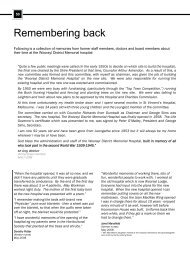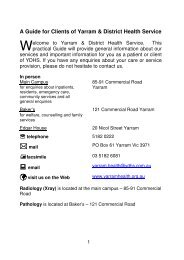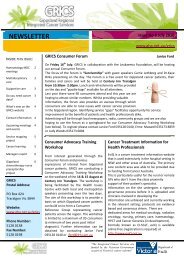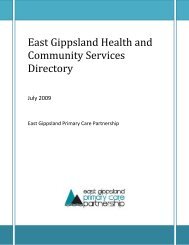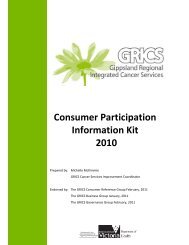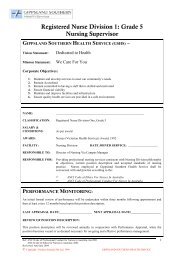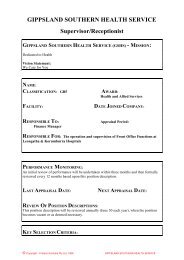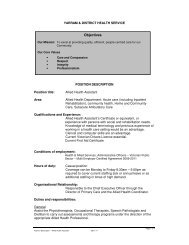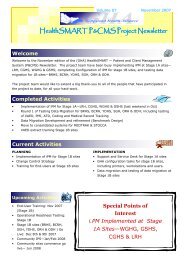Building for a brighter future - GHA Central
Building for a brighter future - GHA Central
Building for a brighter future - GHA Central
You also want an ePaper? Increase the reach of your titles
YUMPU automatically turns print PDFs into web optimized ePapers that Google loves.
Review of Operations: Quality Report<br />
area, with no falls occurring in the<br />
acute area resulting in serious injury.<br />
In the aged care area with an<br />
additional 30 high care residents (who<br />
have a higher risk of falling) there was<br />
a 3.5% increase in the falls resulting in<br />
minor injury and a 1% increase in falls<br />
resulting in serious injury.<br />
As part of the awareness campaign,<br />
the increased emphasis on incident<br />
reporting and an additional 30 high<br />
care residents in aged care, 601 falls<br />
were reported this year, 24 more than<br />
last year, an increase of 4%.<br />
Pressure areas<br />
For the last three years, WGHG has<br />
participated in the Victorian Pressure<br />
Ulcer Point Prevalence study. This<br />
study aims to identify the prevalence<br />
of pressure ulcers by measuring the<br />
number of patients with evidence<br />
of pressure areas on a set day. The<br />
results of the study are then compared<br />
against other Victorian public<br />
hospitals and against previous results.<br />
During the year, based on the results<br />
and assessment of equipment needs,<br />
WGHG implemented a number of<br />
pressure prevention strategies.<br />
Pressure relieving seating surfaces,<br />
heel boots and 10 dynamic mattresses<br />
were purchased with a generous<br />
donation of $16,963 donated by the<br />
Drouin Auxiliary. Nursing education<br />
of assessment and pressure area<br />
prevention was implemented with a<br />
catch cry of “zero tolerance to pressure<br />
areas”.<br />
This year the results show a dramatic<br />
decrease in pressure point prevalence,<br />
in part, due to these strategies.<br />
40<br />
35<br />
30<br />
25<br />
20<br />
15<br />
10<br />
Pressure Ulcer Point<br />
Prevalence Survey %<br />
PUPPS 1<br />
2003<br />
PUPPS 2<br />
2004<br />
PUPPS 3<br />
2006<br />
Managing demands<br />
<strong>for</strong> elective surgery<br />
WGHG is committed to monitoring<br />
and improving access <strong>for</strong> our<br />
community to elective surgery<br />
and other acute inpatient services.<br />
During the year, the elective surgery<br />
waiting list reached over 800 patients<br />
and the length of time patients were<br />
on the list was well above the average<br />
of other rural hospitals.<br />
To help manage this demand,<br />
and with funding provided by DHS,<br />
Newly appointed Elective Surgery<br />
Access Coordinator Debbie Cole<br />
discusses the waiting list with orthopaedic<br />
surgeon Mr George Owen.<br />
An Elective Surgery Access<br />
Coordinator was appointed in March.<br />
An extensive audit of the waiting list<br />
and a preliminary gap analysis was<br />
carried out identifying barriers to<br />
timely access <strong>for</strong> elective surgery<br />
patients and those requiring admission<br />
from the Emergency Department.<br />
The waiting list audit process involved<br />
contact with hundreds of patients<br />
on the elective surgery waiting list,<br />
particularly those who had been on<br />
the list <strong>for</strong> some time. This provided<br />
the opportunity <strong>for</strong> patients to ask<br />
questions about the waiting list and<br />
also identified more than 200 patients<br />
who, <strong>for</strong> a range of reasons, no longer<br />
Surgical Ward nurse Sheree Blum<br />
adjusts a compression device fitted<br />
to the patient following surgery to reduce<br />
the risk of developing deep vein thrombosis.<br />
Preventing Deep Vein Thrombosis<br />
and Pulmonary Embolis<br />
This year, all clinical areas<br />
implemented practices to prevent the<br />
occurrence of Deep Vein Thrombosis<br />
(DVT) and Pulmonary Emboli (PE).<br />
Deep Vein Thromboses are blood clots<br />
in the larger veins, usually the veins<br />
of the legs. Pulmonary Emboli are<br />
blood clots in the lungs. Research<br />
show that DVTs and PEs are a major<br />
and largely preventable cause of<br />
complications in hospitals around<br />
the world.<br />
With these clots occurring 100 times<br />
more frequently among hospitalised<br />
patients than amongst those in the<br />
community, WGHG is one of 40<br />
hospitals around Australia<br />
24<br />
participating in a project to reduce<br />
the number of patients developing<br />
these blood clots.<br />
An assessment <strong>for</strong>m <strong>for</strong> all patients<br />
and standardised prevention practices<br />
based on evidence recommended<br />
by the National Institute of Clinical<br />
Studies, will be implemented early<br />
next year.<br />
Methods used to help prevent<br />
DVTs and PEs are:<br />
➤ The use of blood thinning<br />
medications<br />
➤ Anti-embolytic stockings<br />
➤ Sequential compression devices<br />
used mainly in the operating theatre<br />
to prevent blood from pooling in the<br />
legs during operations<br />
➤ Early mobilisation or exercises




